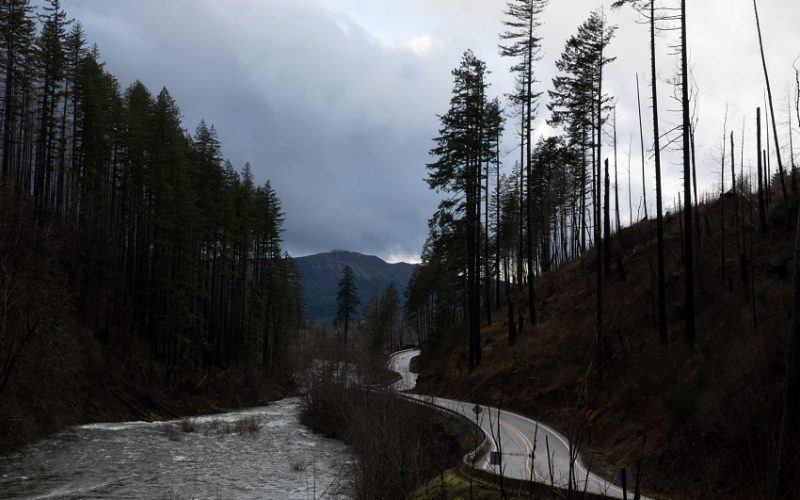Salem, OR – A new report from the Oregon Department of Forestry (ODF) has determined that the 2020 Santiam Canyon fire was not caused by downed power lines, as previously alleged by plaintiffs in a class action lawsuit, but rather by embers drifting from the nearby Beachie Creek fire. The findings, which were released today to the Oregon Journalism Project under a public records request, are a significant victory for PacifiCorp, the utility company embroiled in legal proceedings related to the devastating fire.
The investigation, which spanned several years, found that while downed power lines did ignite some smaller fires, these fires were quickly extinguished by homeowners and firefighters. ODF officials concluded that the most likely cause of the fires in Santiam Canyon was spot fires created by hot embers from the Beachie Creek fire, which was burning upwind at the time. The report explains that the rising heat from a megafire like Beachie Creek can create large convection columns, which can carry firebrands, or embers, long distances and ignite spot fires in areas far from the original fire.
“ODF investigators did not find any evidence that reported powerline ignitions had contributed to the overall spread of the fire in the Santiam Canyon,” the report stated. “The most probable explanation for these ignitions is spot fires from the main Beachie Creek Fire, which was burning upwind of the ignitions in the Santiam Canyon.”
The fire, which burned more than 400,000 acres, killed five people, and devastated the towns of Gates and Lyons, was one of the most destructive wildfires of 2020. The ODF report further stated that while some downed PacifiCorp power lines did spark fires, these were not significant contributors to the larger fire’s spread, contradicting claims made in the class action lawsuit filed by local residents. The fire destroyed the ODF’s regional headquarters in Mehama and caused widespread damage across the region.
Simon Gutierrez, a spokesman for PacifiCorp, praised the ODF’s findings. “The ODF’s thorough investigation uncovered no evidence that any power line ignitions played a significant role in the fire’s spread in the Santiam Canyon,” he said. “Instead, as the ODF concluded, there were other ignitions in the area where no roads or power lines were present. The most probable explanation for these ignitions is spot fires from the main Beachie Creek Fire.”
The report’s findings are a crucial development for PacifiCorp, which was found by a jury in 2023 to be grossly negligent in failing to shut off power during the fires. The jury’s decision led to a significant damages award for the plaintiffs, with each resident receiving about $6 million. However, the legal process to determine final damages is moving slowly and may take up to a decade to complete. PacifiCorp has since appealed the jury’s verdict.
Cody Berne, an attorney for the plaintiffs, emphasized that the jury’s decision was based on thorough evidence presented during the trial. “A jury of 12 Oregonians heard nearly two months of evidence,” Berne said. “The parties took dozens of under-oath depositions, gathered thousands of records, and presented experts on both sides. The jury found that PacifiCorp’s negligence was a substantial factor in burning the Santiam Canyon and even found that PacifiCorp acted willfully and recklessly, ultimately awarding punitive damages based on the evidence it saw at trial.”
The ODF investigation was hindered by several factors, including limited access to crucial evidence. The report noted that both the U.S. Forest Service and PacifiCorp obstructed the investigation. ODF was unable to analyze electrical equipment and powerline hardware in the Gates and Mill City areas due to the utility’s restoration efforts. Additionally, the Forest Service declined to allow its employees to be interviewed by state investigators, forcing ODF to file public records requests to obtain key documents.
Despite these challenges, the ODF’s report casts doubt on the arguments presented by plaintiffs in the ongoing legal battle. However, it remains unclear how the findings will impact the status of the James case, which is central to the class action lawsuit. The case has become a focal point in Oregon’s broader debate over utility responsibility and wildfire prevention, with the outcome likely to shape future regulations for utilities in fire-prone regions.
As the legal proceedings continue, the residents of Santiam Canyon, who have already endured the destruction of their homes and communities, are left to grapple with both the emotional and financial costs of the wildfires. For now, the final resolution of their case against PacifiCorp remains uncertain.











